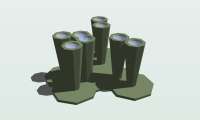VICTIMS OF SYMMETRY
New cities are not established any more. The only way to build an ideal city is to be radical in means. The idea of the project is to trace an axis of symmetry and pull down half of the city. A mirror reflection is constructed to cover the destroyed area. What we get is an ideal city structure. This process is repeated every 30 years. Gradually, the city plan becomes more and more complicated, a lot of twin buildings and streets appear. The process is not only an urban undertaking but also an experiment on a live society. Human behaviour keeps evolving due to changes in the surrounding area. Division into better and worse districts becomes useless. As the time goes, several identical structures are built. This phenomenon makes inhabitants' identification with their place a problem. The time comes when this ideal city turns into 'symmetrical chaos' full of strange objects - victims of symmetry.
The project is strongly connected with Warsaw, the city I was born in, but it can be easily adapted to another city. It was inspired with chaos of architecture typical of this area. Going back to history, it seems obvious that Warsaw was deprived of chances for continuity of its development. The war and communism had stamped the city tissue with changes and decisions characterized by the lack of reasonable planning. The city structure consists of superimposed layers, so there are lots of weird objects and relics of the past. Victims of Symmetry is an attempt to bring order to the city according to the rules defined in the previous stage of this project. At the same time, it refers to the Enlightenment idea of an ideal city and the utopian belief that solving spatial problems would improve human relationships (Claude-Nicolas Ledoux).
Realization of the project would set the city in order only on the surface. By and by, the paradise would have become hell. The process embraced in the project produces victims of symmetry. These objects and places originated from the real ones, to be found in today's Warsaw (a bus stop, a telephone box at the Central Railway Station, a footbridge and an underground passage), yet after several rearrangements they look more like hybrids and ghosts of the ideal city.
Marcin Chomicki
VICTIMS OF SYMMETRY
New cities are not established any more. The only way to build an ideal city is to be radical in means. The idea of the project is to trace an axis of symmetry and pull down half of the city. A mirror reflection is constructed to cover the destroyed area. What we get is an ideal city structure. This process is repeated every 30 years. Gradually, the city plan becomes more and more complicated, a lot of twin buildings and streets appear. The process is not only an urban undertaking but also an experiment on a live society. Human behaviour keeps evolving due to changes in the surrounding area. Division into better and worse districts becomes useless. As the time goes, several identical structures are built. This phenomenon makes inhabitants' identification with their place a problem. The time comes when this ideal city turns into 'symmetrical chaos' full of strange objects - victims of symmetry.
The project is strongly connected with Warsaw, the city I was born in, but it can be easily adapted to another city. It was inspired with chaos of architecture typical of this area. Going back to history, it seems obvious that Warsaw was deprived of chances for continuity of its development. The war and communism had stamped the city tissue with changes and decisions characterized by the lack of reasonable planning. The city structure consists of superimposed layers, so there are lots of weird objects and relics of the past. Victims of Symmetry is an attempt to bring order to the city according to the rules defined in the previous stage of this project. At the same time, it refers to the Enlightenment idea of an ideal city and the utopian belief that solving spatial problems would improve human relationships (Claude-Nicolas Ledoux).
Realization of the project would set the city in order only on the surface. By and by, the paradise would have become hell. The process embraced in the project produces victims of symmetry. These objects and places originated from the real ones, to be found in today's Warsaw (a bus stop, a telephone box at the Central Railway Station, a footbridge and an underground passage), yet after several rearrangements they look more like hybrids and ghosts of the ideal city.
Marcin Chomicki
